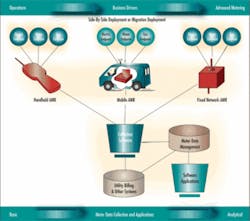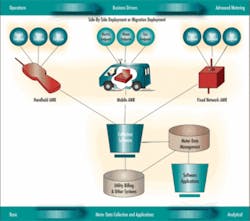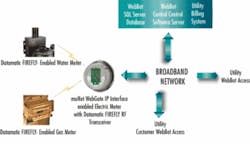The Successful AMI Marriage: When Water AMR and Electric AMI Converge
by Ralph E. Abbott
After knocking a lamp into the bathtub to electrocute a bad guy in the 1964 movie “Goldfinger,” the hero James Bond wryly comments with a smirk, “Shocking. Positively shocking!” We are taught from an early age that electricity and water don’t mix. But these days, when it comes to metering, they do mix, very nicely indeed!
The US Federal Energy Policy Act of 2005 sets forth explicit requirements for electric utilities that require them to investigate and, in most cases, deploy so-called “smart metering.” These “smart metering” or Advanced Metering Infrastructure (AMI) systems rely on fixed telecommunications systems that reach every consumer’s electric meter. Most of these systems are also readily capable of recovering water metering information from the same customer. That evolution could speed the spread of advanced metering in the water industry.
Background
No one is untouched by the spiraling cost of energy: in the fuel for our vehicles, heat for our homes, the electricity that powers our lives, and the information age in which we live. While water and gas can be stored to help ensure continuous delivery, that’s not the case for electricity. We cannot economically and efficiently store significant quantities, which is a big problem. You may have heard the observation that “electricity is the one commodity that is consumed the instant it is manufactured!”
The cost of providing electricity changes dramatically over a 24-hour day, a seven-day week, seasonally and annually. Most electric utilities would like to price their product in relation to its cost. This can be done with time-sensitive or peak sensitive rates that mirror the cost of serving a customer in the cost-fluid environment.
So what has all of this to do with a water utility? Section 1252 of the 2005 Energy Policy Act basically tells most electric utilities that they must offer Time of Use (TOU) rates to their customers or, if not, must have a good reason why not. The compliance burden falls to state regulatory commissions for investor-owned utilities (IOUs), and to the Boards of Directors of most publicly owned utilities.
The next question is, “How shall we implement TOU rates from a metering standpoint?” This simple answer is, “You must use smart meters!”
The definition of smart meters is constantly evolving, but today it means that the electric utility shall deploy communicating electric meters capable of acquiring meter readings for each hour of each day (every 15 minutes in some states!). The information must be transmitted at least daily, and must flow to the utility over a “fixed network infrastructure,” which allows data to be collected remotely and automatically, without meter reading personnel or roving vehicles in the field.
The communication system must also be two-way to support remotely programmable meters. This allows meters to be reconfigured to support almost any likely rate design. Other requirements may include meter tamper detection, power quality monitoring, power outage notification, and other features. Taken together, this widely deployed population of “smart meters” forms an Advanced Metering Infrastructure (AMI) system.
The term AMI is used in contrast to the term “Automatic Meter Reading” (AMR) system, which today usually means a mobile, one-way data acquisition process, conducted by terminal that is either handheld or mounted in a vehicle. Generally speaking, mobile AMR systems cannot support daily collection of time-of-use data or remote meter reprogramming, which is why most electric utilities are moving deliberately toward fully functioning AMI systems. This is good news for water utilities, because many electric AMI systems are designed to support water utility metering.
An electric AMI system handles water metering by using a short range radio frequency (RF) link between the water meter and the electric meter or between the water meter and the electric AMI system’s supporting infrastructure. In the first case, water consumption data is transmitted over a low power link to the electric meter. Then the electric meter sends both the water and the electric data up through the communication “food chain” until they reach the “head-end” of the AMI system. This is typically a computer that performs the data network management function of the system. In the second case, the water meter reports to a data collection infrastructure also used by the electric meters.
Let’s first consider this crucial radio link that transports the water meter data to the electric meter or system infrastructure. How well does this work? Well, that depends on the specific communication technology employed, the distance between these meters, where and how the water meter is located, and many other considerations.
Battery life is a critical issue for communicating water meters. Unlike the communicating electric meter, which obviously has ample power for its communications, we don’t have this luxury at the water meter. The communicating water meter must rely on batteries. And we obviously want to obtain the longest possible period of performance between battery changes!
The battery life issue is at the center of many design trade-offs. How often shall we transmit? How short or long – how many bytes - is the transmitted message? What is the transmit power level? How much extra power does it take to communicate with pit set meters? Does the RF link between the electric meter and the water meter in any way interfere with RF communication between the electric meter and the “head-end”?
Each AMI vendor develops its own approach to these issues. Most offer forms of pre-engineered solutions for local-area communication between water and electric meters. For example, the Badger Orion™ communication link to water and gas meters is already available in the electric AMI products offered by Current Communications, Aclara (DCSI), Hunt and Tantalus.
The communicating electric meter by muNet incorporates the Datamatic Firefly® RF technology, thus allowing smooth integration of water, gas and electric metering from a single customer’s location.
Communicating water meters in the Sensus FlexNet® AMI system “speak” to a data collector or concentrator on a tower, just as the electric meters do. The electric and water meters can also speak with each other to form a durable communication link in the event that a few of them can’t “see” the tower well enough to communicate successfully. A meter that can see the tower serves as a data relay “buddy” to one that can’t. The meters first attempt direct-to-tower communication. Only if there is difficulty with that transmission will a subsequent water meter transmission seek and establish “buddy mode” help from nearby meters.
In the Elster EnergyAxis® AMI system, the electric meters form a resilient radio “mesh”. Water and gas meters take advantage of the electric meters’ mesh network without assuming the communications burdens of supporting it. The electric meters in the mesh network regularly communicate with each other, which is fine for electric meters but not for water or gas, because the frequent transmissions would drain the batteries. The EnergyAxis electric meters receive communications input from water and gas meters, but water and gas meters do not have full “partnership” in the mesh; they do not relay other meters’ data.
The Itron Openway® AMI system, like many others, supports a local area communications concept called a “Home Area Network” (HAN). In this implementation, the 2-way HAN network extends from the electric meter into the customer’s premises to provide information and tools that allow consumers to respond to TOU and other innovative electric rates. The HAN will support customer-owned displays, load control devices, and communicating thermostats, and is capable of gathering data for the utility from these and other sources, including other meters. Itron’s Openway does not presently serve water meters, but Itron does offer its Fixed Network System 2.5 for water metering.
The market will eventually determine which HAN technologies will prevail. One currently popular approach to the HAN is to use ZigBee™, a short range RF technology for consumer products. Another approach might utilize a power line communication technology such as HomePlug™. Some factors to balance include cost, range, penetration of building materials, sources of interference, communications overhead (capacity required to support message structure), and protocol stability and commercial availability over the 20-year lifetime of most AMI systems. Some suppliers think this HAN network could allow gas and water communications with electric meters.
The communicating water meter approaches mentioned here are all designed to assure long battery life (20 years is claimed by most suppliers) and robust communications under difficult circumstances.
Fixed network metering systems that serve both electric and water have been available for many years, with ample testimonials praising their performance and value. The newer “smart metering” or AMI systems now being selected by utilities are vastly more powerful, and most systems are capable of electric, water and gas metering.
What does the future hold? Fixed network systems are now steadily replacing the manual reading or “drive-by” AMR systems that have served electric utilities so well in the past. Electric utilities have their sights set on reducing their costs and “carbon footprint” through peak load management, improved operating efficiencies, and operational savings from “Smart Grid” features mentioned earlier.
Municipal water utilities with an electric counterpart should communicate soon and often. Most AMI system investments rest on a complex business case. Using the same infrastructure for both electric and water (and gas) obviously enhances that case. The water utility can help the electric utility make its case, and both utilities will reap the benefits.
Water utilities lying within the service territory of an IOU also need to communicate with those utilities soon and often. Most IOUs are delighted to discuss sharing the infrastructure, and in being fairly compensated for that arrangement.
Surprisingly, many promising initial discussions do not lead to mutually beneficial results. Why? First, many of the electric AMI systems have to be specified to include water metering interfaces – up front, when the system is ordered. Usually the cost increment to include water, if any, is minimal. But no electric utility wishes to incur the cost if no realistic prospect exists for utilizing the interfaces. This means the concurrence of decisions and commitments by the electric utility and the water utility is crucial. If the water utility is held up for approvals by six months past the “go” date of the electric utility, the water opportunity may be lost permanently. Some AMI systems fortunately permit the later addition of water metering to an existing and installed electric AMI system.
We sometimes hear of joint metering discussions breaking down over alleged concerns about data security and privacy issues. Today, this is more likely an excuse for parting company than a valid point of contention. In this information era, utilities and their suppliers of AMI and Meter Data Management (MDM) systems are amply prepared to provide rigorous data protection assurances to each utility and all parties, including the utility customers.
There are other perceived obstacles in the path of progress too. These may range from personnel issues (displaced meter readers) to fear of loss of control in a shared AMI infrastructure arrangement.
However, the trend is clear: water and electric utilities that step up to the plate of joint metering early will be the winners, as will their customers.
About the Author:
Ralph E. Abbott has been involved in remote automatic metering since the 1973 Arab Oil Embargo. He has been an officer of two leading advanced metering system suppliers. In 1985 he became founder/president of one of the leading consulting engineering firms in the AMR/AMI field: Plexus Research, Inc. In 2007, Plexus Research was acquired by R.W. Beck, a provider of expert technical services to water and energy utilities. He is a Registered Professional Engineer, a charter member of Utilimetrics (formerly the AMRA), and serves on the advisory committees of several national conferences. He may be reached at: [email protected].


